看雪.腾讯TSRC 2017 CTF 秋季赛 第六题点评及解析思路
导语
各位小伙伴们周末快乐~
第六题终于结束了,最终有两人挑战成功!分别是风间仁和hotwinter,恭喜!

第六题作者以两人攻破此题的成绩,登上防守方第一名的位置。
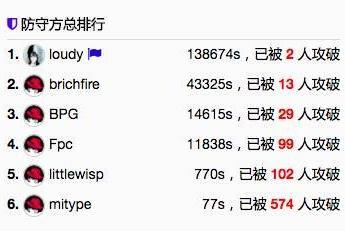
防守方hotwinter 逆袭至第一名,风间仁在短暂的落后之后,再次重回第三名。
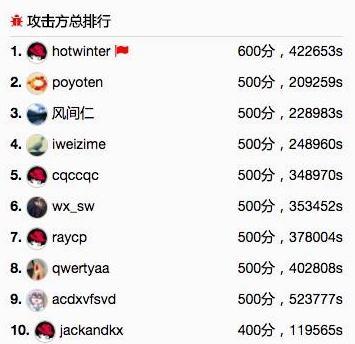
现在还剩三题,比赛愈发紧张。
究竟谁能夺取最后的胜利呢?我们翘首以望。各位选手,加油!
接下来让我们一起来看看第六题的点评、出题思路和解析。
看雪评委netwind点评
作者采用了修改过的DES算法对数据进行了加密。然后将加密结果转换为大数,用miracl库做大数计算。最后调用luajit脚本执行大整数计算,把计算结果和内存数据进行对比验证。破解此题要识别出正确的luajit版本号并反编译luajit脚本,识别作者实现的FFT大数乘法,识别DES函数的修改点并实现解密函数才能完成。
第六题作者简介
loudy,2007年接触看雪,热衷编程、特别是逆向分析。当前从事工作出于保密规定暂不公开。爱好跑步、篮球、电影。在论坛多以潜水学习为主,也希望多认识有相同爱好的朋友。
第六题设计思路
程序设计流程清楚,未加壳,未做任何反逆向手段,但存在几个坑点,以下一一说明:
1、输入长度未固定,需要分析(16-24位)。
2、对输入做DES加密,但该DES被修改。
(1)表
/*
char DES::Expand_Table[EXPAND_SIZE] = {
31, 0, 1, 2, 3, 4,
3, 4, 5, 6, 7, 8,
7, 8, 9,10,11,12,
11,12,13,14,15,16,
15,16,17,18,19,20,
19,20,21,22,23,24,
23,24,25,26,27,28,
27,28,29,30,31, 0};
*/
被修改为
char DES::Expand_Table[EXPAND_SIZE] = {
0, 0, 1, 2, 3, 3,
4, 4, 5, 6, 7, 7,
8, 8, 9,10,11,11,
12,12,13,14,15,15,
16,16,17,18,19,19,
20,20,21,22,23,23,
24,24,25,26,27,27,
28,28,29,30,31,31};
改变了加密结果,需要分析出来。
(2)块加密时(8字节),置换表的使用顺序和子密钥的使用顺序做了改变。
IP_Transform(bitStr);
std::string halfBitStr;
halfBitStr.resize(bitStr.size() / 2);
std::string eBitStr;
eBitStr.resize(EXPAND_SIZE);
for(int i = SUBKEY_NUM-1; i >= 0; --i)
{
Expand_Transform(bitStr.substr(bitStr.size() / 2), eBitStr);
XOR(eBitStr, std::string(subKey[i],SUBKEY_LENGHT), SUBKEY_LENGHT);
SBox_Transform(eBitStr, halfBitStr);
Permute_Transform(halfBitStr);
XOR(bitStr, halfBitStr, halfBitStr.size());
if(i != 0)
LeftCycle(bitStr, 0, bitStr.size(), bitStr.size() / 2);
}
IP_1_Transform(bitStr);
(3)全文加密时,多加了一个异或操作,改变加密结果,需要分析出来。
for(size_t i = 1; i < plain.size() / 8; ++i)
{
block = plain.substr(i * 8, 8);
for(int j=0;j<8;j++)
{
block[j] = block[j]^tmpblock[7-j];
}
EncryptBlock(block, subKey);
result.append(block);
tmpblock.assign(block);
}
3、加密结果转换为大数,用miracl库做大数计算。
(1)调用函数multiply与173做乘法运算。
big bigx = mirvar(0);
bigx->len = 1;
bigx->w[0] = 173;
multiply(bigx,bigtmp1,bigx);
(2)调用函数fft_mult与0x719做乘法运算。
big bigy = mirvar(0);
bigy->len = 1;
bigy->w[0] = 0x719;
fft_mult(bigx,bigy,bigy);
但其中动了小手脚(在fft_mult最后做了一次乘方运算和一次减法运算,减1001)。
power(z,2,z,z);
decr(z,1001,z);
4、调用自己实现的FFT乘法,乘以317。
int* out1 = mull(desOut,"317");
5、调用luajit脚本执行大整数计算。
--xut c程序导入的参数
--func1加法
--func2减法
--func3乘法
local
yyy =
"1574592838300862641516215149137548264158058079230003764126382984039489925466995870724568174393389905601620735902909057604303543552180706761904"
function myst()
c = func1(xut,"1001")
d = 0
for i=1,100 do
for j=1,100 do
c = func1(c,"1001")
end
c = func1(c,"10101")
end
c = func3(c,"983751509373")
for i=1,13 do
c = func2(c,"1023")
for j=1,14 do
c = func2(c,"1203")
for k=1,15 do
c = func2(c,"1230")
for l=1,16 do
c = func2(c,"1231")
end
end
end
end
c = func1(c,"1")
c = func3(c,"2")
e = get(c)
--print(e)
lene = string.len(e)
leny = string.len(yyy)
if(lene==leny)
then
--print("same length")
--[ local variable definition --]
i = 1
d = 1
--[ while loop execution --]
while( i <= lene )
do
if(string.byte(e,i)~=string.byte(yyy,i))
then
--[ terminate the loop using break statement --]
d = 0
break
end
i = i+1
end
end
return d
end
计算结果和固定值“1574592838300862641516215149137548264158058079230003764126382984039489925466995870724568174393389905601620735902909057604303543552180706761904”比较,相等则注册成功,不然失败。但此处也有坑,我把luajit版本号改了,本来是luajit2.0.5,我把字符串改为luajit2.1.0-beta3,反编译难度加大。
破解思路
1、 识别正确luajit版本号,反编译luajit脚本,理清其中流程,通过固定值“1574592838300862641516215149137548264158058079230003764126382984039489925466995870724568174393389905601620735902909057604303543552180706761904”,得到luajit脚本的正确输入。
2、 识别自己实现的FFT大数乘法,反推乘法函数mull的输入。
3、 识别miracl库,并找到fft_mult函数的修改点(函数最后),反推fft_mult的输入。
4、 反推multiply的输入,并转化为16进制。
5、 识别DES函数的修改点,并自己实现解密函数,将上一步结果解密,得到最终的key(“KXCTF201710BYLoudy08”),破解完成。
下面选取 hotwinter 的破解分析
这题真的是做的我想砸墙……前前后后花了不下24小时……各种坑……放弃HITCON一直在刚……
这题是一道数学 + 密码学 + lua + C++ STL的极其恶心人的一道题……大概一共分为三大部分,其中掺杂了各种不常见的库函数和更改过的库函数……这题经验就是善用工具……
首先惯例直接上strings
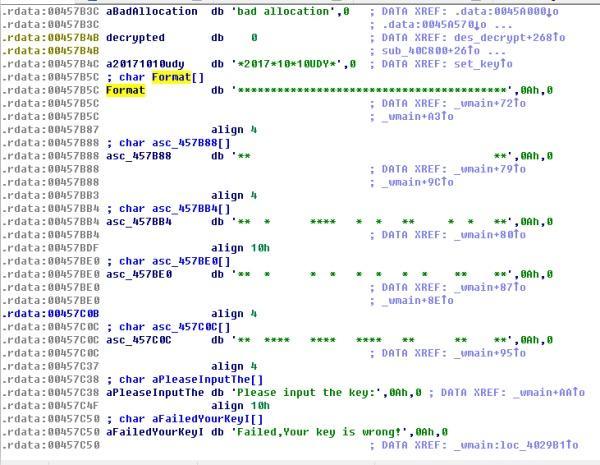
跟着引用找到main函数,如下
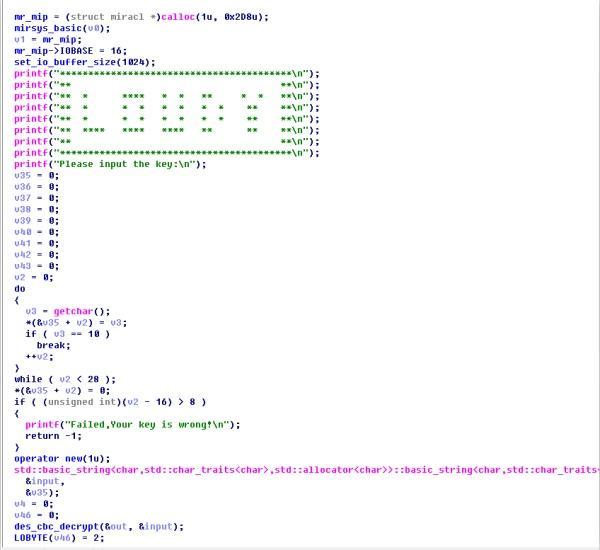
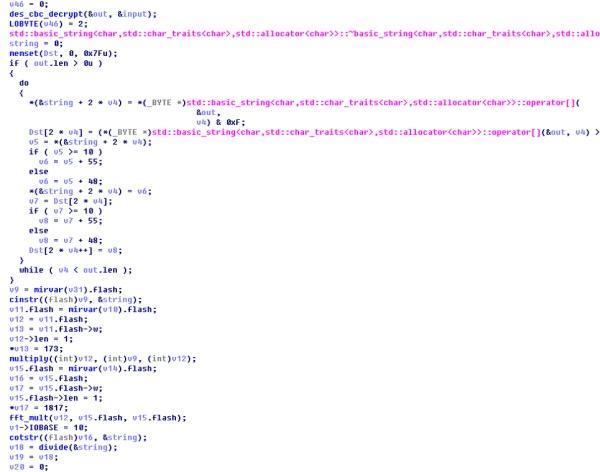


大概可以看出逻辑如下,我们的输入会经过两个大结构的变换,第一个是des_decrypt(之后我们会说怎么识别他),第二个是MIRACL的大整数操作,我们输入做了以下两个操作以后,会扔进lua里面进行第三次操作,最终进行比较,大致逻辑就是这样
首先先说一下库函数都是怎么识别出来的吧(DES是人工扒算法和常数扒出来的……),这里用到了bindiff这个工具https://www.zynamics.com/software.html,他会比较两个idb之间每个函数的相似性,并列出最相似的函数,对于像MIRACL和LuaJIT这种开源程序来说很好用。我们需要做的就是下载对应版本的源码,编译成exe/dll
(因为linux下calling convention不同,所以bindiff可能识别没那么准确(大概))以后开IDA执行一遍初始分析,然后存储idb后退出。注意这里每个版本都最好建debug build,这样大部分的函数名称会被保留,并生成pdb。bindiff目前还没有支持IDA7.0……也就是我为什么换回了IDA 6.95……
LuaJIT很好编译……直接扔vs command line tools里面跑他的mvcsbuild就好了,这里查看build的bat脚本后发现假如第一个参数是debug的话,他就会建成debug build(即 mvsbuild.exe
debug)非常方便,因此lua库函数立马就标完了(不过这里实际执行的时候遇到了问题……luaji2.1.0-beta3使用的是2.0版的Opcode按理说并不能跑起来……即使改成1.0版也还是会出错……不知道为什么程序里面可以用2.1.0-beta3这个build……)。lua库函数所在的文件是lua51.dll,不是luajit.exe,不过lua库函数改动不大,所以bindiff识别准确率还是挺高的。所有lua的C API函数基本上都是bindiff识别的
MIRACL这个东西就dt了……我们知道用了MIRACL是因为strings里面的这句话

MIRACL的build只有一个脚本在lib/ms32doit.bat……而且写的非常糟糕……手动加了一些编译
flag以后终于是可以编译了……生成文件为miracl.lib
(用起来不是很方便,于是改编译脚本为dll),MIRACL的识别准确率香蕉LuaJIT来说就没有那么高了……不是很清楚为什么,不过用的也不算太多,所以还好,这里可以点开第一个mirsys_basic函数,然后照着源码把miracl的结构体给撸出来(因为有各种ifndef之类的……所以没法直接看源码撸),这样之后会方便很多
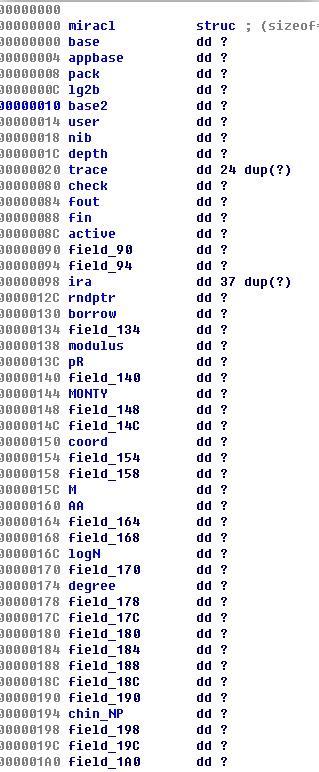
这里我们注意到一点,MIRACL其实是有stack
backtrace的,他的识别关键在于miracl结构体中trace这个结构(这也是为什么我们要照着mirsys_basic撸结构体的原因),找到这个以后我们MIRACL的识别就很简单了。stack trace主要是靠MR_IN()组成,每个主要函数都有自己的数字,所以只要对照这个就能找到大部分的函数了,这里以power为例子进行说明
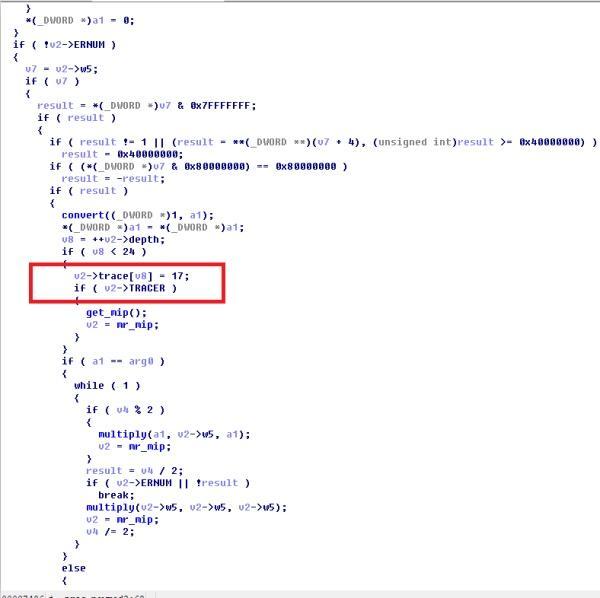
红框中标出的即为该函数的MR_IN的stack trace number,下面我们直接grep 源码目录就可找到对应的定义
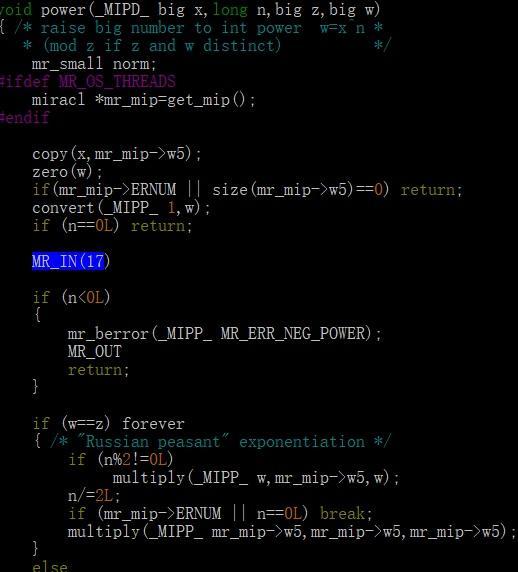
MIRACL几乎没有说明文档……所有东西都是靠我自己从源码里面翻出来的……dt,这里我还用到了cscope这个工具来在本地快速查找C和C++ project的函数定义很引用(有时候grep的结果太多了),使用方法很简单
find . -iname "*.c" -o -iname "*.cpp" -o -iname "*.hpp" -o -iname "*.h" > cscope.files (这里可以加任何你想要的文件后缀,只要find函数能找到就行)
cscope -bqk (建立索引)
cscope -d (避免重复建立索引)
个人感觉cscope只适合相对较小的project……如果是linux kernel那种……最好还是自己搭一个opengrok的服务器比较好
基本库函数标完……下面就进入正式的逆向工作……
一。des_cbc_decrypt
这个函数是des cbc的解密(加密?)函数,作者更改了很多的常量……使得我们不得不自己找一个des的库更改后使用。des的识别是靠了这串数组
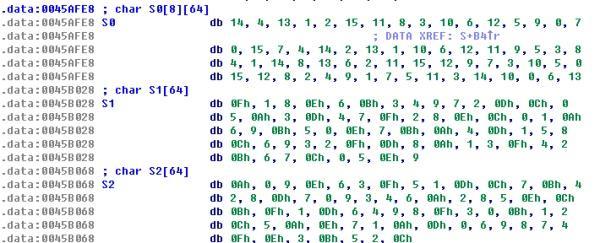
以16进制数组搜索(搜 0xe,0x4,0xd,0x1,0x2,0xf,0xb,0x8,0x3,0xa,0x6,0xc)可找到http://kodu.ut.ee/~lipmaa/teaching/crypto2000/des/des.C,查看后,发现是DES的sbox,由于des并不是所有操作都需要用到table,找到一个和所给des相似的库找了我很长时间(这里也是刚开始觉得常量不会改……),最终选用了这个https://gist.githubusercontent.com/eigenein/1275094/raw/62d1fee5e9d19df44fab6950ecbcd9c82b9b9805/pyDes.py
根据这个算法,对应的des的表改过来就好了(有个表只改了一个字节……实在是很坑爹)。des的key
schedule用到的表也需要改(给的例子里面bits是按MSB encode的这个也需要改)。同时des_decrypt里面roundkey是从最后一轮开始的……(也就是为什么我说他是decrypt),但cbc的算法明显是block
cipher的加密算法……这里还要翻一下iv。同时des_decrypt里面对调Ininital
permutation和final permutation,调整后des的代码(3DES我懒得删了)
#############################################################################
# Documentation #
#############################################################################
# Author: Todd Whiteman
# Date: 16th March, 2009
# Verion: 2.0.0
# License: Public Domain - free to do as you wish
# Homepage: http://twhiteman.netfirms.com/des.html
#
# This is a pure python implementation of the DES encryption algorithm.
# It's pure python to avoid portability issues, since most DES
# implementations are programmed in C (for performance reasons).
#
# Triple DES class is also implemented, utilising the DES base. Triple DES
# is either DES-EDE3 with a 24 byte key, or DES-EDE2 with a 16 byte key.
#
# See the README.txt that should come with this python module for the
# implementation methods used.
#
# Thanks to:
# * David Broadwell for ideas, comments and suggestions.
# * Mario Wolff for pointing out and debugging some triple des CBC errors.
# * Santiago Palladino for providing the PKCS5 padding technique.
# * Shaya for correcting the PAD_PKCS5 triple des CBC errors.
#
"""A pure python implementation of the DES and TRIPLE DES encryption algorithms.
Class initialization
--------------------
pyDes.des(key, [mode], [IV], [pad], [padmode])
pyDes.triple_des(key, [mode], [IV], [pad], [padmode])
key -> Bytes containing the encryption key. 8 bytes for DES, 16 or 24 bytes
for Triple DES
mode -> Optional argument for encryption type, can be either
pyDes.ECB (Electronic Code Book) or pyDes.CBC (Cypher Block Chaining)
IV -> Optional Initial Value bytes, must be supplied if using CBC mode.
Length must be 8 bytes.
pad -> Optional argument, set the pad character (PAD_NORMAL) to use during
all encrypt/decrpt operations done with this instance.
padmode -> Optional argument, set the padding mode (PAD_NORMAL or PAD_PKCS5)
to use during all encrypt/decrpt operations done with this instance.
I recommend to use PAD_PKCS5 padding, as then you never need to worry about any
padding issues, as the padding can be removed unambiguously upon decrypting
data that was encrypted using PAD_PKCS5 padmode.
Common methods
--------------
encrypt(data, [pad], [padmode])
decrypt(data, [pad], [padmode])
data -> Bytes to be encrypted/decrypted
pad -> Optional argument. Only when using padmode of PAD_NORMAL. For
encryption, adds this characters to the end of the data block when
data is not a multiple of 8 bytes. For decryption, will remove the
trailing characters that match this pad character from the last 8
bytes of the unencrypted data block.
padmode -> Optional argument, set the padding mode, must be one of PAD_NORMAL
or PAD_PKCS5). Defaults to PAD_NORMAL.
Example
-------
from pyDes import *
data = "Please encrypt my data"
k = des("DESCRYPT", CBC, "\0\0\0\0\0\0\0\0", pad=None, padmode=PAD_PKCS5)
# For Python3, you'll need to use bytes, i.e.:
# data = b"Please encrypt my data"
# k = des(b"DESCRYPT", CBC, b"\0\0\0\0\0\0\0\0", pad=None, padmode=PAD_PKCS5)
d = k.encrypt(data)
print "Encrypted: %r" % d
print "Decrypted: %r" % k.decrypt(d)
assert k.decrypt(d, padmode=PAD_PKCS5) == data
See the module source (pyDes.py) for more examples of use.
You can also run the pyDes.py file without and arguments to see a simple test.
Note: This code was not written for high-end systems needing a fast
implementation, but rather a handy portable solution with small usage.
"""
import sys
# _pythonMajorVersion is used to handle Python2 and Python3 differences.
_pythonMajorVersion = sys.version_info[0]
# Modes of crypting / cyphering
ECB = 0
CBC = 1
# Modes of padding
PAD_NORMAL = 1
PAD_PKCS5 = 2
# PAD_PKCS5: is a method that will unambiguously remove all padding
# characters after decryption, when originally encrypted with
# this padding mode.
# For a good description of the PKCS5 padding technique, see:
# http://www.faqs.org/rfcs/rfc1423.html
# The base class shared by des and triple des.
class _baseDes(object):
def __init__(self, mode=ECB, IV=None, pad=None, padmode=PAD_NORMAL):
if IV:
IV = self._guardAgainstUnicode(IV)
if pad:
pad = self._guardAgainstUnicode(pad)
self.block_size = 8
# Sanity checking of arguments.
if pad and padmode == PAD_PKCS5:
raise ValueError("Cannot use a pad character with PAD_PKCS5")
if IV and len(IV) != self.block_size:
raise ValueError("Invalid Initial Value (IV), must be a multiple of " + str(self.block_size) + " bytes")
# Set the passed in variables
self._mode = mode
self._iv = IV
self._padding = pad
self._padmode = padmode
def getKey(self):
"""getKey() -> bytes"""
return self.__key
def setKey(self, key):
"""Will set the crypting key for this object."""
key = self._guardAgainstUnicode(key)
self.__key = key
def getMode(self):
"""getMode() -> pyDes.ECB or pyDes.CBC"""
return self._mode
def setMode(self, mode):
"""Sets the type of crypting mode, pyDes.ECB or pyDes.CBC"""
self._mode = mode
def getPadding(self):
"""getPadding() -> bytes of length 1. Padding character."""
return self._padding
def setPadding(self, pad):
"""setPadding() -> bytes of length 1. Padding character."""
if pad is not None:
pad = self._guardAgainstUnicode(pad)
self._padding = pad
def getPadMode(self):
"""getPadMode() -> pyDes.PAD_NORMAL or pyDes.PAD_PKCS5"""
return self._padmode
def setPadMode(self, mode):
"""Sets the type of padding mode, pyDes.PAD_NORMAL or pyDes.PAD_PKCS5"""
self._padmode = mode
def getIV(self):
"""getIV() -> bytes"""
return self._iv
def setIV(self, IV):
"""Will set the Initial Value, used in conjunction with CBC mode"""
if not IV or len(IV) != self.block_size:
raise ValueError("Invalid Initial Value (IV), must be a multiple of " + str(self.block_size) + " bytes")
IV = self._guardAgainstUnicode(IV)
self._iv = IV
def _padData(self, data, pad, padmode):
# Pad data depending on the mode
if padmode is None:
# Get the default padding mode.
padmode = self.getPadMode()
if pad and padmode == PAD_PKCS5:
raise ValueError("Cannot use a pad character with PAD_PKCS5")
if padmode == PAD_NORMAL:
if len(data) % self.block_size == 0:
# No padding required.
return data
if not pad:
# Get the default padding.
pad = self.getPadding()
if not pad:
raise ValueError("Data must be a multiple of " + str(self.block_size) + " bytes in length. Use padmode=PAD_PKCS5 or set the pad character.")
data += (self.block_size - (len(data) % self.block_size)) * pad
elif padmode == PAD_PKCS5:
pad_len = 8 - (len(data) % self.block_size)
if _pythonMajorVersion < 3:
data += pad_len * chr(pad_len)
else:
data += bytes([pad_len] * pad_len)
return data
def _unpadData(self, data, pad, padmode):
# Unpad data depending on the mode.
if not data:
return data
if pad and padmode == PAD_PKCS5:
raise ValueError("Cannot use a pad character with PAD_PKCS5")
if padmode is None:
# Get the default padding mode.
padmode = self.getPadMode()
if padmode == PAD_NORMAL:
if not pad:
# Get the default padding.
pad = self.getPadding()
if pad:
data = data[:-self.block_size] + \
data[-self.block_size:].rstrip(pad)
elif padmode == PAD_PKCS5:
if _pythonMajorVersion < 3:
pad_len = ord(data[-1])
else:
pad_len = data[-1]
data = data[:-pad_len]
return data
def _guardAgainstUnicode(self, data):
# Only accept byte strings or ascii unicode values, otherwise
# there is no way to correctly decode the data into bytes.
if _pythonMajorVersion < 3:
if isinstance(data, unicode):
raise ValueError("pyDes can only work with bytes, not Unicode strings.")
else:
if isinstance(data, str):
# Only accept ascii unicode values.
try:
return data.encode('ascii')
except UnicodeEncodeError:
pass
raise ValueError("pyDes can only work with encoded strings, not Unicode.")
return data
#############################################################################
# DES #
#############################################################################
class des(_baseDes):
"""DES encryption/decrytpion class
Supports ECB (Electronic Code Book) and CBC (Cypher Block Chaining) modes.
pyDes.des(key,[mode], [IV])
key -> Bytes containing the encryption key, must be exactly 8 bytes
mode -> Optional argument for encryption type, can be either pyDes.ECB
(Electronic Code Book), pyDes.CBC (Cypher Block Chaining)
IV -> Optional Initial Value bytes, must be supplied if using CBC mode.
Must be 8 bytes in length.
pad -> Optional argument, set the pad character (PAD_NORMAL) to use
during all encrypt/decrpt operations done with this instance.
padmode -> Optional argument, set the padding mode (PAD_NORMAL or
PAD_PKCS5) to use during all encrypt/decrpt operations done
with this instance.
"""
# Permutation and translation tables for DES
__pc1 = [56, 48, 40, 32, 24, 16, 8,
0, 57, 49, 41, 33, 25, 17,
9, 1, 58, 50, 42, 34, 26,
18, 10, 2, 59, 51, 43, 35,
62, 54, 46, 38, 30, 22, 14,
6, 61, 53, 45, 37, 29, 21,
13, 5, 60, 52, 44, 36, 28,
20, 12, 4, 27, 19, 11, 3
]
# number left rotations of pc1
# changed!
__left_rotations = [
0x17, 0xa, 2, 5, 9, 2, 3, 2, 3, 2, 5, 7, 2, 9, 2, 7
]
# permuted choice key (table 2)
# changed!
__pc2 = [
13, 16, 10, 23, 0, 4,
2, 27, 14, 5, 20, 9,
22, 18, 11, 3, 25, 7,
15, 6, 26, 19, 12, 1,
40, 51, 30, 36, 46, 54,
29, 39, 50, 44, 32, 46,
43, 48, 38, 55, 33, 52,
45, 41, 49, 35, 28, 31
]
# initial permutation IP
__ip = [57, 49, 41, 33, 25, 17, 9, 1,
59, 51, 43, 35, 27, 19, 11, 3,
61, 53, 45, 37, 29, 21, 13, 5,
63, 55, 47, 39, 31, 23, 15, 7,
56, 48, 40, 32, 24, 16, 8, 0,
58, 50, 42, 34, 26, 18, 10, 2,
60, 52, 44, 36, 28, 20, 12, 4,
62, 54, 46, 38, 30, 22, 14, 6
]
# Expansion table for turning 32 bit blocks into 48 bits
__expansion_table = [
0, 0, 1, 2, 3, 3,
4, 4, 5, 6, 7, 7,
8, 8, 9, 10, 11, 11,
12, 12, 13, 14, 15, 15,
16, 16, 17, 18, 19, 19,
20, 20, 21, 22, 23, 23,
24, 24, 25, 26, 27, 27,
28, 28, 29, 30, 31, 31
]
# The (in)famous S-boxes
__sbox = [
# S1
[14, 4, 13, 1, 2, 15, 11, 8, 3, 10, 6, 12, 5, 9, 0, 7,
0, 15, 7, 4, 14, 2, 13, 1, 10, 6, 12, 11, 9, 5, 3, 8,
4, 1, 14, 8, 13, 6, 2, 11, 15, 12, 9, 7, 3, 10, 5, 0,
15, 12, 8, 2, 4, 9, 1, 7, 5, 11, 3, 14, 10, 0, 6, 13],
# S2
[15, 1, 8, 14, 6, 11, 3, 4, 9, 7, 2, 13, 12, 0, 5, 10,
3, 13, 4, 7, 15, 2, 8, 14, 12, 0, 1, 10, 6, 9, 11, 5,
0, 14, 7, 11, 10, 4, 13, 1, 5, 8, 12, 6, 9, 3, 2, 15,
13, 8, 10, 1, 3, 15, 4, 2, 11, 6, 7, 12, 0, 5, 14, 9],
# S3
[10, 0, 9, 14, 6, 3, 15, 5, 1, 13, 12, 7, 11, 4, 2, 8,
13, 7, 0, 9, 3, 4, 6, 10, 2, 8, 5, 14, 12, 11, 15, 1,
13, 6, 4, 9, 8, 15, 3, 0, 11, 1, 2, 12, 5, 10, 14, 7,
1, 10, 13, 0, 6, 9, 8, 7, 4, 15, 14, 3, 11, 5, 2, 12],
# S4
[7, 13, 14, 3, 0, 6, 9, 10, 1, 2, 8, 5, 11, 12, 4, 15,
13, 8, 11, 5, 6, 15, 0, 3, 4, 7, 2, 12, 1, 10, 14, 9,
10, 6, 9, 0, 12, 11, 7, 13, 15, 1, 3, 14, 5, 2, 8, 4,
3, 15, 0, 6, 10, 1, 13, 8, 9, 4, 5, 11, 12, 7, 2, 14],
# S5
[2, 12, 4, 1, 7, 10, 11, 6, 8, 5, 3, 15, 13, 0, 14, 9,
14, 11, 2, 12, 4, 7, 13, 1, 5, 0, 15, 10, 3, 9, 8, 6,
4, 2, 1, 11, 10, 13, 7, 8, 15, 9, 12, 5, 6, 3, 0, 14,
11, 8, 12, 7, 1, 14, 2, 13, 6, 15, 0, 9, 10, 4, 5, 3],
# S6
[12, 1, 10, 15, 9, 2, 6, 8, 0, 13, 3, 4, 14, 7, 5, 11,
10, 15, 4, 2, 7, 12, 9, 5, 6, 1, 13, 14, 0, 11, 3, 8,
9, 14, 15, 5, 2, 8, 12, 3, 7, 0, 4, 10, 1, 13, 11, 6,
4, 3, 2, 12, 9, 5, 15, 10, 11, 14, 1, 7, 6, 0, 8, 13],
# S7
[4, 11, 2, 14, 15, 0, 8, 13, 3, 12, 9, 7, 5, 10, 6, 1,
13, 0, 11, 7, 4, 9, 1, 10, 14, 3, 5, 12, 2, 15, 8, 6,
1, 4, 11, 13, 12, 3, 7, 14, 10, 15, 6, 8, 0, 5, 9, 2,
6, 11, 13, 8, 1, 4, 10, 7, 9, 5, 0, 15, 14, 2, 3, 12],
# S8
[13, 2, 8, 4, 6, 15, 11, 1, 10, 9, 3, 14, 5, 0, 12, 7,
1, 15, 13, 8, 10, 3, 7, 4, 12, 5, 6, 11, 0, 14, 9, 2,
7, 11, 4, 1, 9, 12, 14, 2, 0, 6, 10, 13, 15, 3, 5, 8,
2, 1, 14, 7, 4, 10, 8, 13, 15, 12, 9, 0, 3, 5, 6, 11],
]
# 32-bit permutation function P used on the output of the S-boxes
__p = [
15, 6, 19, 20, 28, 11,
27, 16, 0, 14, 22, 25,
4, 17, 30, 9, 1, 7,
23,13, 31, 26, 2, 8,
18, 12, 29, 5, 21, 10,
3, 24
]
# final permutation IP^-1
__fp = [
39, 7, 47, 15, 55, 23, 63, 31,
38, 6, 46, 14, 54, 22, 62, 30,
37, 5, 45, 13, 53, 21, 61, 29,
36, 4, 44, 12, 52, 20, 60, 28,
35, 3, 43, 11, 51, 19, 59, 27,
34, 2, 42, 10, 50, 18, 58, 26,
33, 1, 41, 9, 49, 17, 57, 25,
32, 0, 40, 8, 48, 16, 56, 24
]
# Type of crypting being done
ENCRYPT = 0x00
DECRYPT = 0x01
# Initialisation
def __init__(self, key, mode=ECB, IV=None, pad=None, padmode=PAD_NORMAL):
# Sanity checking of arguments.
if len(key) != 8:
raise ValueError("Invalid DES key size. Key must be exactly 8 bytes long.")
_baseDes.__init__(self, mode, IV, pad, padmode)
self.key_size = 8
self.L = []
self.R = []
self.Kn = [ [0] * 48 ] * 16 # 16 48-bit keys (K1 - K16)
self.final = []
self.setKey(key)
def setKey(self, key):
"""Will set the crypting key for this object. Must be 8 bytes."""
_baseDes.setKey(self, key)
self.__create_sub_keys()
def __String_to_BitList(self, data):
"""Turn the string data, into a list of bits (1, 0)'s"""
if _pythonMajorVersion < 3:
# Turn the strings into integers. Python 3 uses a bytes
# class, which already has this behaviour.
data = [ord(c) for c in data]
l = len(data) * 8
result = [0] * l
pos = 0
for ch in data:
i = 0
while i <= 7:
result[pos] = (ch >> i) & 1
pos += 1
i += 1
return result
def __BitList_to_String(self, data):
"""Turn the list of bits -> data, into a string"""
result = []
pos = 0
c = 0
while pos < len(data):
c += data[pos] << (pos % 8)
if (pos % 8) == 7:
result.append(c)
c = 0
pos += 1
if _pythonMajorVersion < 3:
return ''.join([ chr(c) for c in result ])
else:
return bytes(result)
def __permutate(self, table, block):
"""Permutate this block with the specified table"""
return list(map(lambda x: block[x], table))
# Transform the secret key, so that it is ready for data processing
# Create the 16 subkeys, K[1] - K[16]
def __create_sub_keys(self):
"""Create the 16 subkeys K[1] to K[16] from the given key"""
key = self.__permutate(des.__pc1, self.__String_to_BitList(self.getKey()))
i = 0
# Split into Left and Right sections
self.L = key[:28]
self.R = key[28:]
while i < 16:
j = 0
# Perform circular left shifts
while j < des.__left_rotations[i]:
self.L.append(self.L[0])
del self.L[0]
self.R.append(self.R[0])
del self.R[0]
j += 1
# Create one of the 16 subkeys through pc2 permutation
self.Kn[i] = self.__permutate(des.__pc2, self.L + self.R)
i += 1
# Main part of the encryption algorithm, the number cruncher :)
def __des_crypt(self, block, crypt_type):
"""Crypt the block of data through DES bit-manipulation"""
block = self.__permutate(des.__fp, block)
self.L = block[:32]
self.R = block[32:]
# Encryption starts from Kn[1] through to Kn[16]
if crypt_type == des.ENCRYPT:
iteration = 0
iteration_adjustment = 1
# Decryption starts from Kn[16] down to Kn[1]
else:
iteration = 15
iteration_adjustment = -1
i = 0
while i < 16:
# Make a copy of R[i-1], this will later become L[i]
tempR = self.R[:]
# Permutate R[i - 1] to start creating R[i]
self.R = self.__permutate(des.__expansion_table, self.R)
# Exclusive or R[i - 1] with K[i], create B[1] to B[8] whilst here
self.R = list(map(lambda x, y: x ^ y, self.R, self.Kn[iteration]))
B = [self.R[:6], self.R[6:12], self.R[12:18], self.R[18:24], self.R[24:30], self.R[30:36], self.R[36:42], self.R[42:]]
# Optimization: Replaced below commented code with above
#j = 0
#B = []
#while j < len(self.R):
# self.R[j] = self.R[j] ^ self.Kn[iteration][j]
# j += 1
# if j % 6 == 0:
# B.append(self.R[j-6:j])
# Permutate B[1] to B[8] using the S-Boxes
j = 0
Bn = [0] * 32
pos = 0
while j < 8:
# Work out the offsets
m = (B[j][0] << 1) + B[j][5]
n = (B[j][1] << 3) + (B[j][2] << 2) + (B[j][3] << 1) + B[j][4]
# Find the permutation value
v = des.__sbox[j][(m << 4) + n]
#print hex(j * 48 + (m << 4 + n))
# Turn value into bits, add it to result: Bn
Bn[pos] = (v & 8) >> 3
Bn[pos + 1] = (v & 4) >> 2
Bn[pos + 2] = (v & 2) >> 1
Bn[pos + 3] = v & 1
pos += 4
j += 1
# Permutate the concatination of B[1] to B[8] (Bn)
self.R = self.__permutate(des.__p, Bn)
# Xor with L[i - 1]
self.R = list(map(lambda x, y: x ^ y, self.R, self.L))
# Optimization: This now replaces the below commented code
#j = 0
#while j < len(self.R):
# self.R[j] = self.R[j] ^ self.L[j]
# j += 1
# L[i] becomes R[i - 1]
self.L = tempR
i += 1
iteration += iteration_adjustment
# Final permutation of R[16]L[16]
self.final = self.__permutate(des.__ip, self.R + self.L)
return self.final
# Data to be encrypted/decrypted
def crypt(self, data, crypt_type):
"""Crypt the data in blocks, running it through des_crypt()"""
# Error check the data
if not data:
return ''
if len(data) % self.block_size != 0:
if crypt_type == des.DECRYPT: # Decryption must work on 8 byte blocks
raise ValueError("Invalid data length, data must be a multiple of " + str(self.block_size) + " bytes\n.")
if not self.getPadding():
raise ValueError("Invalid data length, data must be a multiple of " + str(self.block_size) + " bytes\n. Try setting the optional padding character")
else:
data += (self.block_size - (len(data) % self.block_size)) * self.getPadding()
# print "Len of data: %f" % (len(data) / self.block_size)
if self.getMode() == CBC:
if self.getIV():
iv = self.__String_to_BitList(self.getIV())
else:
raise ValueError("For CBC mode, you must supply the Initial Value (IV) for ciphering")
# Split the data into blocks, crypting each one seperately
i = 0
dict = {}
result = []
#cached = 0
#lines = 0
while i < len(data):
# Test code for caching encryption results
#lines += 1
#if dict.has_key(data[i:i+8]):
#print "Cached result for: %s" % data[i:i+8]
# cached += 1
# result.append(dict[data[i:i+8]])
# i += 8
# continue
block = self.__String_to_BitList(data[i:i+8])
# Xor with IV if using CBC mode
if self.getMode() == CBC:
if crypt_type == des.ENCRYPT:
block = list(map(lambda x, y: x ^ y, block, iv))
#j = 0
#while j < len(block):
# block[j] = block[j] ^ iv[j]
# j += 1
processed_block = self.__des_crypt(block, crypt_type)
if crypt_type == des.DECRYPT:
processed_block = list(map(lambda x, y: x ^ y, processed_block, iv))
#j = 0
#while j < len(processed_block):
# processed_block[j] = processed_block[j] ^ iv[j]
# j += 1
iv = block
else:
iv = processed_block
else:
processed_block = self.__des_crypt(block, crypt_type)
# Add the resulting crypted block to our list
#d = self.__BitList_to_String(processed_block)
#result.append(d)
result.append(self.__BitList_to_String(processed_block))
#dict[data[i:i+8]] = d
i += 8
# print "Lines: %d, cached: %d" % (lines, cached)
# Return the full crypted string
if _pythonMajorVersion < 3:
return ''.join(result)
else:
return bytes.fromhex('').join(result)
def encrypt(self, data, pad=None, padmode=None):
"""encrypt(data, [pad], [padmode]) -> bytes
data : Bytes to be encrypted
pad : Optional argument for encryption padding. Must only be one byte
padmode : Optional argument for overriding the padding mode.
The data must be a multiple of 8 bytes and will be encrypted
with the already specified key. Data does not have to be a
multiple of 8 bytes if the padding character is supplied, or
the padmode is set to PAD_PKCS5, as bytes will then added to
ensure the be padded data is a multiple of 8 bytes.
"""
data = self._guardAgainstUnicode(data)
if pad is not None:
pad = self._guardAgainstUnicode(pad)
data = self._padData(data, pad, padmode)
return self.crypt(data, des.ENCRYPT)
def decrypt(self, data, pad=None, padmode=None):
"""decrypt(data, [pad], [padmode]) -> bytes
data : Bytes to be encrypted
pad : Optional argument for decryption padding. Must only be one byte
padmode : Optional argument for overriding the padding mode.
The data must be a multiple of 8 bytes and will be decrypted
with the already specified key. In PAD_NORMAL mode, if the
optional padding character is supplied, then the un-encrypted
data will have the padding characters removed from the end of
the bytes. This pad removal only occurs on the last 8 bytes of
the data (last data block). In PAD_PKCS5 mode, the special
padding end markers will be removed from the data after decrypting.
"""
data = self._guardAgainstUnicode(data)
if pad is not None:
pad = self._guardAgainstUnicode(pad)
data = self.crypt(data, des.DECRYPT)
return self._unpadData(data, pad, padmode)
#############################################################################
# Triple DES #
#############################################################################
class triple_des(_baseDes):
"""Triple DES encryption/decrytpion class
This algorithm uses the DES-EDE3 (when a 24 byte key is supplied) or
the DES-EDE2 (when a 16 byte key is supplied) encryption methods.
Supports ECB (Electronic Code Book) and CBC (Cypher Block Chaining) modes.
pyDes.des(key, [mode], [IV])
key -> Bytes containing the encryption key, must be either 16 or
24 bytes long
mode -> Optional argument for encryption type, can be either pyDes.ECB
(Electronic Code Book), pyDes.CBC (Cypher Block Chaining)
IV -> Optional Initial Value bytes, must be supplied if using CBC mode.
Must be 8 bytes in length.
pad -> Optional argument, set the pad character (PAD_NORMAL) to use
during all encrypt/decrpt operations done with this instance.
padmode -> Optional argument, set the padding mode (PAD_NORMAL or
PAD_PKCS5) to use during all encrypt/decrpt operations done
with this instance.
"""
def __init__(self, key, mode=ECB, IV=None, pad=None, padmode=PAD_NORMAL):
_baseDes.__init__(self, mode, IV, pad, padmode)
self.setKey(key)
def setKey(self, key):
"""Will set the crypting key for this object. Either 16 or 24 bytes long."""
self.key_size = 24 # Use DES-EDE3 mode
if len(key) != self.key_size:
if len(key) == 16: # Use DES-EDE2 mode
self.key_size = 16
else:
raise ValueError("Invalid triple DES key size. Key must be either 16 or 24 bytes long")
if self.getMode() == CBC:
if not self.getIV():
# Use the first 8 bytes of the key
self._iv = key[:self.block_size]
if len(self.getIV()) != self.block_size:
raise ValueError("Invalid IV, must be 8 bytes in length")
self.__key1 = des(key[:8], self._mode, self._iv,
self._padding, self._padmode)
self.__key2 = des(key[8:16], self._mode, self._iv,
self._padding, self._padmode)
if self.key_size == 16:
self.__key3 = self.__key1
else:
self.__key3 = des(key[16:], self._mode, self._iv,
self._padding, self._padmode)
_baseDes.setKey(self, key)
# Override setter methods to work on all 3 keys.
def setMode(self, mode):
"""Sets the type of crypting mode, pyDes.ECB or pyDes.CBC"""
_baseDes.setMode(self, mode)
for key in (self.__key1, self.__key2, self.__key3):
key.setMode(mode)
def setPadding(self, pad):
"""setPadding() -> bytes of length 1. Padding character."""
_baseDes.setPadding(self, pad)
for key in (self.__key1, self.__key2, self.__key3):
key.setPadding(pad)
def setPadMode(self, mode):
"""Sets the type of padding mode, pyDes.PAD_NORMAL or pyDes.PAD_PKCS5"""
_baseDes.setPadMode(self, mode)
for key in (self.__key1, self.__key2, self.__key3):
key.setPadMode(mode)
def setIV(self, IV):
"""Will set the Initial Value, used in conjunction with CBC mode"""
_baseDes.setIV(self, IV)
for key in (self.__key1, self.__key2, self.__key3):
key.setIV(IV)
def encrypt(self, data, pad=None, padmode=None):
"""encrypt(data, [pad], [padmode]) -> bytes
data : bytes to be encrypted
pad : Optional argument for encryption padding. Must only be one byte
padmode : Optional argument for overriding the padding mode.
The data must be a multiple of 8 bytes and will be encrypted
with the already specified key. Data does not have to be a
multiple of 8 bytes if the padding character is supplied, or
the padmode is set to PAD_PKCS5, as bytes will then added to
ensure the be padded data is a multiple of 8 bytes.
"""
ENCRYPT = des.ENCRYPT
DECRYPT = des.DECRYPT
data = self._guardAgainstUnicode(data)
if pad is not None:
pad = self._guardAgainstUnicode(pad)
# Pad the data accordingly.
data = self._padData(data, pad, padmode)
if self.getMode() == CBC:
self.__key1.setIV(self.getIV())
self.__key2.setIV(self.getIV())
self.__key3.setIV(self.getIV())
i = 0
result = []
while i < len(data):
block = self.__key1.crypt(data[i:i+8], ENCRYPT)
block = self.__key2.crypt(block, DECRYPT)
block = self.__key3.crypt(block, ENCRYPT)
self.__key1.setIV(block)
self.__key2.setIV(block)
self.__key3.setIV(block)
result.append(block)
i += 8
if _pythonMajorVersion < 3:
return ''.join(result)
else:
return bytes.fromhex('').join(result)
else:
data = self.__key1.crypt(data, ENCRYPT)
data = self.__key2.crypt(data, DECRYPT)
return self.__key3.crypt(data, ENCRYPT)
def decrypt(self, data, pad=None, padmode=None):
"""decrypt(data, [pad], [padmode]) -> bytes
data : bytes to be encrypted
pad : Optional argument for decryption padding. Must only be one byte
padmode : Optional argument for overriding the padding mode.
The data must be a multiple of 8 bytes and will be decrypted
with the already specified key. In PAD_NORMAL mode, if the
optional padding character is supplied, then the un-encrypted
data will have the padding characters removed from the end of
the bytes. This pad removal only occurs on the last 8 bytes of
the data (last data block). In PAD_PKCS5 mode, the special
padding end markers will be removed from the data after
decrypting, no pad character is required for PAD_PKCS5.
"""
ENCRYPT = des.ENCRYPT
DECRYPT = des.DECRYPT
data = self._guardAgainstUnicode(data)
if pad is not None:
pad = self._guardAgainstUnicode(pad)
if self.getMode() == CBC:
self.__key1.setIV(self.getIV())
self.__key2.setIV(self.getIV())
self.__key3.setIV(self.getIV())
i = 0
result = []
while i < len(data):
iv = data[i:i+8]
block = self.__key3.crypt(iv, DECRYPT)
block = self.__key2.crypt(block, ENCRYPT)
block = self.__key1.crypt(block, DECRYPT)
self.__key1.setIV(iv)
self.__key2.setIV(iv)
self.__key3.setIV(iv)
result.append(block)
i += 8
if _pythonMajorVersion < 3:
data = ''.join(result)
else:
data = bytes.fromhex('').join(result)
else:
data = self.__key3.crypt(data, DECRYPT)
data = self.__key2.crypt(data, ENCRYPT)
data = self.__key1.crypt(data, DECRYPT)
return self._unpadData(data, pad, padmode)
CBC那里库函数好像有点问题……于是直接调用的ECB模式,然后自己写的CBC,如下,同时可写出逆运算。des_cbc_decrypt之后的hex encode也是先编码低四位,后编码高四位,所以需要更改一下变成16进制的算法
import pyDes
from pwn import xor
from gmpy2 import isqrt_rem
def hexc(inp):
inp = inp.encode("hex")
return "".join(inp[i + 1] + inp[i] for i in range(0, len(inp), 2))
def ihexc(inp):
inp = format(inp, 'x')
inp = '0' * (len(inp) % 2) + inp
return "".join(inp[i + 1] + inp[i] for i in range(0, len(inp), 2)).decode("hex")
def compute(inp):
des = pyDes.des("*2017*10")
rest = len(inp) % 8
if rest:
inp += "\x00" * (8 - rest)
inp = [inp[i:i+8] for i in range(0, len(inp), 8)]
iv = "\x00" * 8
out = [iv]
for i in range(len(inp)):
out.append(des.decrypt(xor(inp[i], out[i][::-1])))
return hexc("".join(out[1:]))
def inv_compute(inp):
des = pyDes.des("*2017*10")
inp = ihexc(inp)
ap = len(inp) % 8
if ap:
inp = "\x00" * (8 - ap) + inp
inp = [inp[i:i+8] for i in range(0, len(inp), 8)]
iv = "\x00" * 8
out = []
for i in range(len(inp)):
out.append(xor(des.encrypt(inp[i]), iv[::-1]))
iv = inp[i]
return "".join(out).rstrip("\x00")
DES 这部分花的时间大概最长……因为C++的STL也不是很好调试……所以只能一轮一轮的对……看是不是改对了……
二. LuaJIT
我刚开始没有直接看MIRACL,因为感觉太烦了……(看见了类似傅里叶变换的东西),所以从最后的lua开始继续逆向,lua字节码和0x5A异或了,这里直接idapython dump出来异或一下就好了,然后得到的是LuaJIT的bytecode(注意不是lua),字节码的enum定义我没有找到……所以主要用了这两个工具。由于之前从来没研究过lua……所以还是花了不少时间的
https://github.com/viruscamp/luadec
看起来好像大家都在用的一个反编译器,可得到源码,缺点:由于是JIT的缘故,所以得不到在函数中使用全局变量引用,导致某些地方看起来很诡异……
而且好像必须要在同一个目录下将文件命名为test.lua才可以执行……(貌似可以改AutoIt脚本,不过懒……)
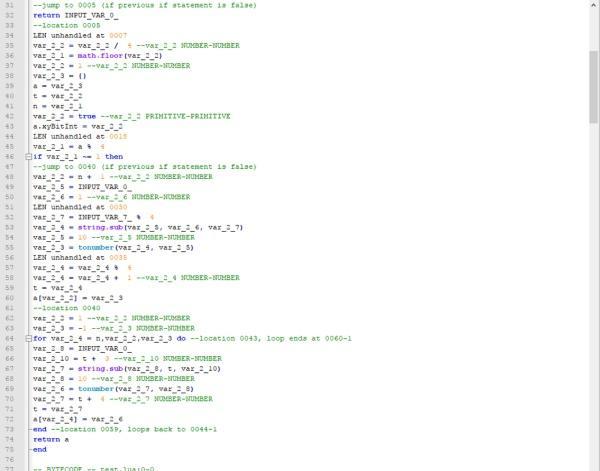
得到的反编译代码大概长这个德行……搜索xyByInt,可以找到这个http://blog.csdn.net/xianyun2009/article/details/44796823,貌似是lua的某个大整数实现
经过精简后,得到的代码大概是这样的
function show(a)
print(get(a))
end
function get(a)
s = {a[#a]}
for i=#a-1, 1, -1 do
table.insert(s, string.format("%04d", a[i]))
end
return table.concat(s, "")
end
function create(s)
if s["xyBitInt"] == true then return s end
n, t, a = math.floor(#s/4), 1, {}
a["xyBitInt"] = true
if #s%4 ~= 0 then a[n + 1], t = tonumber(string.sub(s, 1, #s%4), 10), #s%4 + 1 end
for i = n, 1, -1 do a[i], t= tonumber(string.sub(s, t, t + 3), 10), t + 4 end
return a
end
function add(a,b)
local var_3_2 = create(a)
var_3_3 = create(b)
c = create("0")
t = 0
local var_3_1 = var_3_3
local var_3_0 = var_3_2
for var_3_5 = 1 , math.max(c, var_3_5), 1 do --location 0022, loop ends at 0048-1
if not unknown2 then
--jump to 0028 (if previous if statement is false)
--location 0028
if not unknown3 then
--jump to 0033 (if previous if statement is false)
--location 0033
t = ( t + 0 + 0 )
local var_3_7 = t % uget_3_0
local var_3_8 = math.floor( t / uget_3_0 )
t = var_3_8
c[var_3_5] = var_3_7
end --location 0047, loops back to 0023-1
if t ~= 0 then
--jump to 0068 (if previous if statement is false)
repeat
var_3_4 = t % uget_3_0
local var_3_5 = math.floor( t / uget_3_0 )
t = var_3_5
c[ c + 1 ] = var_3_4
--jump to 0048 (if previous if statement is false)
--location 0068
until false or (previous if statement is true) --location 0068
return c
end
function bsub(a, b)
a, b, c, t = create(a), create(b), create("0"), 0
for i = 1, #a do
c[i] = a[i] - t - (b[i] or 0)
if c[i] < 0 then t, c[i] = 1, c[i] + mod else t = 0 end
end
return c
end
function by(a, b)
a, b, c, t = create(a), create(b), create("0"), 0
for i = 1, #a do
for j = 1, #b do
t = t + (c[i + j - 1] or 0) + a[i] * b[j]
c[i + j - 1], t = t%mod, math.floor(t / mod)
end
if t ~= 0 then c[i + #b], t = t + (c[i + #b] or 0), 0 end
end
return c
end
function myst(xut)
c = add(xut, "1001")
d = 0
for i = 1 , 100 , 1 do --location 0011, loop ends at 0028-1
for j = 1 , 100 , 1 do --location 0015, loop ends at 0022-1
c = add(c, "1001")
end --location 0021, loops back to 0016-1
c = add(c, "10101")
end --location 0027, loops back to 0012-1
c = by(c, "983751509373")
for i = 1 , 13 , 1 do --location 0036, loop ends at 0073-1
c = bsub(c, "1023")
for j = 1 , 14 , 1 do --location 0045, loop ends at 0072-1
c = bsub(c, "1203")
for k = 1 , 15 , 1 do --location 0054, loop ends at 0071-1
c = bsub(c, "1230")
for l = 1 , 16 , 1 do --location 0063, loop ends at 0070-1
c = bsub(c, "1231")
--until false or (previous if statement is true) --location 0068
end --location 0069, loops back to 0064-1
end --location 0070, loops back to 0055-1
end --location 0071, loops back to 0046-1
end --location 0072, loops back to 0037-1
c = add(c, "1")
c = by(c, "2")
e = get(c)
lene = string.len(e)
leny = string.len(uget_6_0)
if lene == leny then
--jump to 0129 (if previous if statement is false)
i = 1
d = 1
if i <= lene then
--jump to 0129 (if previous if statement is false)
repeat
var_6_0 = string.byte(e, i)
local var_6_1 = string.byte(uget_6_0, i)
if var_6_0 ~= var_6_1 then
--jump to 0125 (if previous if statement is false)
d = 0
--jump to 0129 (if previous if statement is false)
i = i + 1
--jump to 0105 (if previous if statement is false)
until false or (previous if statement is true) --location 0129
return d
end
function add(INPUT_VAR_0_)
return INPUT_VAR_0_ + INPUT_VAR_1_
end
function sub(INPUT_VAR_0_)
return INPUT_VAR_0_ - INPUT_VAR_1_
end
function someFunc9()
local var_9_0 = 10000 --var_9_0 NUMBER-NUMBER
local var_9_1 = "1574592838300862641516215149137548264158058079230003764126382984039489925466995870724568174393389905601620735902909057604303543552180706761904" --strings longer than 40 characters get cut
end
还有一些不重要的部分没有化简,不过可以大概看出lua的逻辑了,执行多次运算后,将其化为2进制的字符串和var_9_1做比较。这里刚开始判断错了add,以为是sub,所以写出来的代码不对……然后手动的去更改luaJIT的字节码,在get那里直接return,然后用Lua的C API写了个小的wrapper来测试
#include
#include "lua.h"
#include "lualib.h"
#include "lauxlib.h"
/* Convenience stuff */
static void close_state(lua_State **L) { lua_close(*L); }
#define cleanup(x) __attribute__((cleanup(x)))
#define auto_lclose cleanup(close_state)
int main(int argc, char *argv[])
{
/* Create VM state */
auto_lclose lua_State *L = luaL_newstate();
if (!L)
return 1;
luaL_openlibs(L); /* Open standard libraries */
/* Load config file */
if (argc > 1) {
luaL_loadfile(L, argv[1]); /* (1) */
//luaJIT_setmode(L, 0, 0);
int ret = lua_pcall(L, 0, 0, 0);
if (ret != 0) {
fprintf(stderr, "%s\n", lua_tostring(L, -1));
return 1;
}
}
lua_pushstring(L, argv[2]);
lua_setfield(L, -10002, "xut");
lua_getfield(L, -10002, "myst");
lua_pcall(L, 0, 1, 0);
printf("%s\n", lua_tolstring(L, -1, 0));
lua_settop(L, 0); /* (4) */
return 0;
}
这里简单说一下patch luaJIT字节码的过程,不知道字节码的enum很头疼……于是上网搜索的途中找到了这个有用的工具https://github.com/franko/luajit-lang-toolkit, 其中run.lua的-bx功能可以查看lua字节码对应的16进制字节是什么……让更改字节码变得简单了许多,效果大概是这个样子
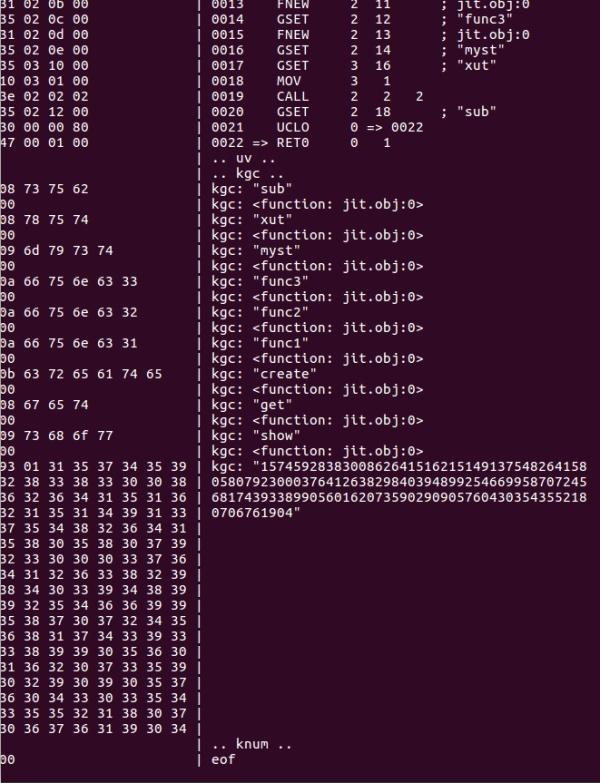
如果要增加一个kgc的话,需要更改的地方有kgc的长度和这段proto的总长度,其中proto总长度是U128LE编码,然后大概学习了一下怎么写luaJIT字节码……后来发现自己把add看成了sub以后解决问题就没啥用了……总的来说lua字节码还是挺难调试的……不知道有没有好的方法……之后可以考虑写个hook的工具之类的……
第一次逆向luaJIT,感觉还是挺有趣的,学到了不少东西,luaJIT代码逆向出来后的逆运算如下
def lua(target):
target = int(target) / 2 - 1
for i in range(13):
for j in range(14):
for k in range(15):
for l in range(16):
target += 1231
target += 1230
target += 1203
target += 1023
target /= 983751509373
for i in range(100):
target -= 10101
for j in range(100):
target -= 1001
target -= 1001
return target
可以看出并不是很困难……大概是当时比较困……所以出了各种差错……
三. MIRACL
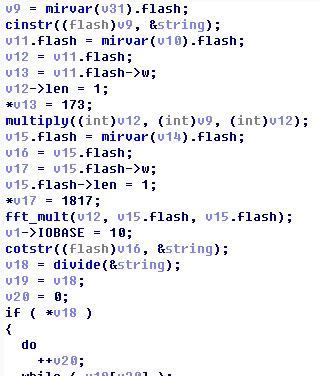
攻破了luaJIT和des以后,就只剩下我们最后的MIRACL了……首先我们来看看他都做了什么
首先把我们des_cbc_decrypt之后的结果16进制化以后变成了一个mirvar的大整数,然后乘了个173,之后做了fft_mult(使用傅里叶变换进行快速大数乘法)1817,以后做了某个计算(其实是除法,这个之后我们说怎么识别出来的)
看起来很简单对不对……结果怎么算怎么不对……fft_mult那里的输出和输入永远对不上……(输入的变换也不是线性的……所以只能逆向了)于是考虑可能fft_mult被更改过了……查看fft_mult
之前都一样……最后居然多出了两行!
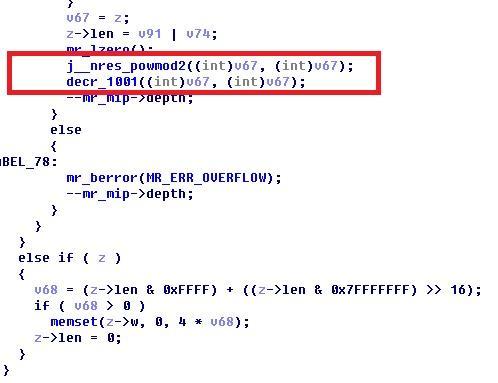
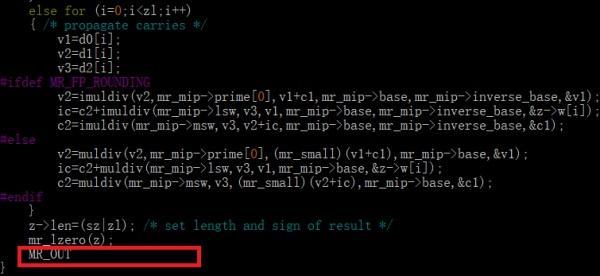
然后通过olly根据输入输出猜测,得到第一个是平方的算法,第二个根据bindiff得到是decr(减法,不过内置了第二个减数为1001)
于是fft_mult的实际算法是 (inp * 1817)^2 - 1001……嗯……怪不得怎么都算不对
最后还差divide那个函数,那个函数长这样……

嗯……看了一眼就不想看了……遂祭出olly的连蒙带猜的的方法……输入了几组数据,观察输出
输入:1
输出:713
输入:2
输出:436
输入:3
输出:159
嗯……这个好像第二个反过来再除以输入就是317啊……验证了一下以后还真是
至此,我们已将所有程序逆向完毕……完整脚本如下
import pyDes
from pwn import xor
from gmpy2 import isqrt_rem
def hexc(inp):
inp = inp.encode("hex")
return "".join(inp[i + 1] + inp[i] for i in range(0, len(inp), 2))
def ihexc(inp):
inp = format(inp, 'x')
inp = '0' * (len(inp) % 2) + inp
return "".join(inp[i + 1] + inp[i] for i in range(0, len(inp), 2)).decode("hex")
def compute(inp):
des = pyDes.des("*2017*10")
rest = len(inp) % 8
if rest:
inp += "\x00" * (8 - rest)
inp = [inp[i:i+8] for i in range(0, len(inp), 8)]
iv = "\x00" * 8
out = [iv]
for i in range(len(inp)):
out.append(des.decrypt(xor(inp[i], out[i][::-1])))
return hexc("".join(out[1:]))
def inv_compute(inp):
des = pyDes.des("*2017*10")
inp = ihexc(inp)
ap = len(inp) % 8
if ap:
inp = "\x00" * (8 - ap) + inp
inp = [inp[i:i+8] for i in range(0, len(inp), 8)]
iv = "\x00" * 8
out = []
for i in range(len(inp)):
out.append(xor(des.encrypt(inp[i]), iv[::-1]))
iv = inp[i]
return "".join(out).rstrip("\x00")
def lua(target):
target = int(target) / 2 - 1
for i in range(13):
for j in range(14):
for k in range(15):
for l in range(16):
target += 1231
target += 1230
target += 1203
target += 1023
target /= 983751509373
for i in range(100):
target -= 10101
for j in range(100):
target -= 1001
target -= 1001
return target
assert(compute("1122334455667788").upper() == "BEC20560FEB6FCEFF93B5F94B3CF259D")
assert(compute("1234567890abcdef").upper() == "C7BF2111CD9A94A30E31F260D9BF9432")
n1 = 0xad
n2 = 0x719
target = "1574592838300862641516215149137548264158058079230003764126382984039489925466995870724568174393389905601620735902909057604303543552180706761904"
target = lua(target)
target = int(str(target)[::-1])
assert(target % 317 == 0)
target /= 317
target += 1001
res, rem = isqrt_rem(target)
assert(int(rem) == 0)
prod = (n2 * n1)
assert(res % prod == 0)
res /= prod
print inv_compute(res)
"""
inp = "0011223344556677"
num1 = int(compute(inp), 16)
num1 *= n1
print hex(num1 * n2)
"""
总结
这题说难也不难……就是很繁琐……而且考察的知识点比较杂……附上我的IDA6.95 idb和解题用的全部代码……感兴趣的人可以看一眼……
看雪.腾讯TSRC 2017 CTF 秋季赛 第一题点评及解析思路
看雪.腾讯TSRC 2017 CTF 秋季赛 第二题点评及解析思路
看雪.腾讯TSRC 2017 CTF 秋季赛 第三题点评及解析思路
看雪.腾讯TSRC 2017 CTF 秋季赛 第四题点评及解析思路
看雪.腾讯TSRC 2017 CTF 秋季赛10月24日开赛,神秘大奖揭晓!
看雪.腾讯TSRC 2017 CTF 秋季赛 明日开赛!你不得不知的参赛指南
【火热报名中】看雪Android 安全训练营,11月17号开课啦!